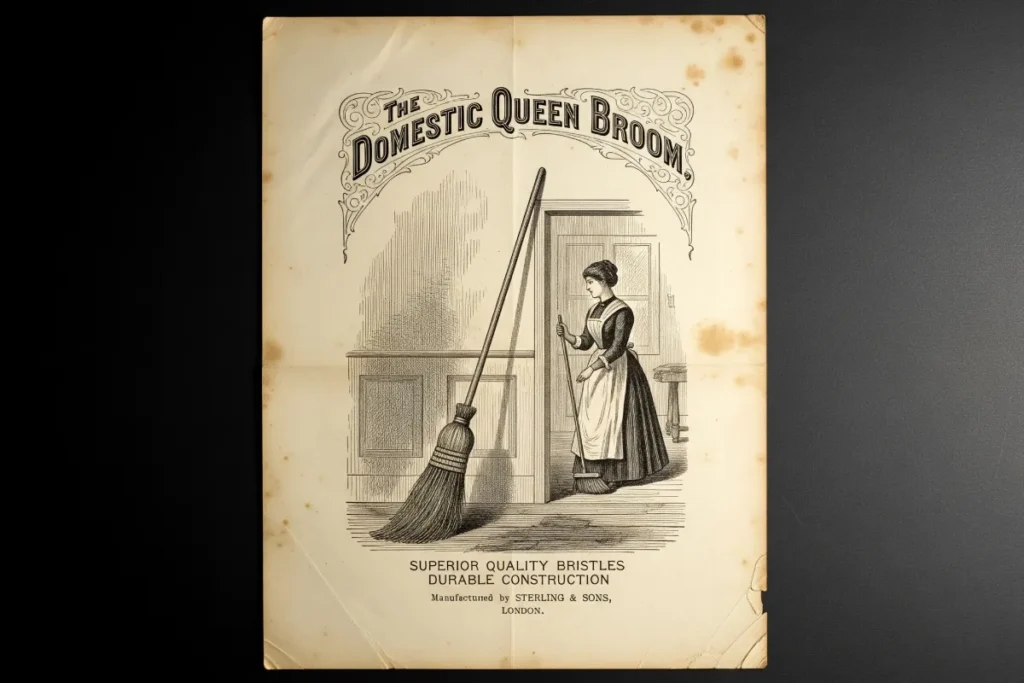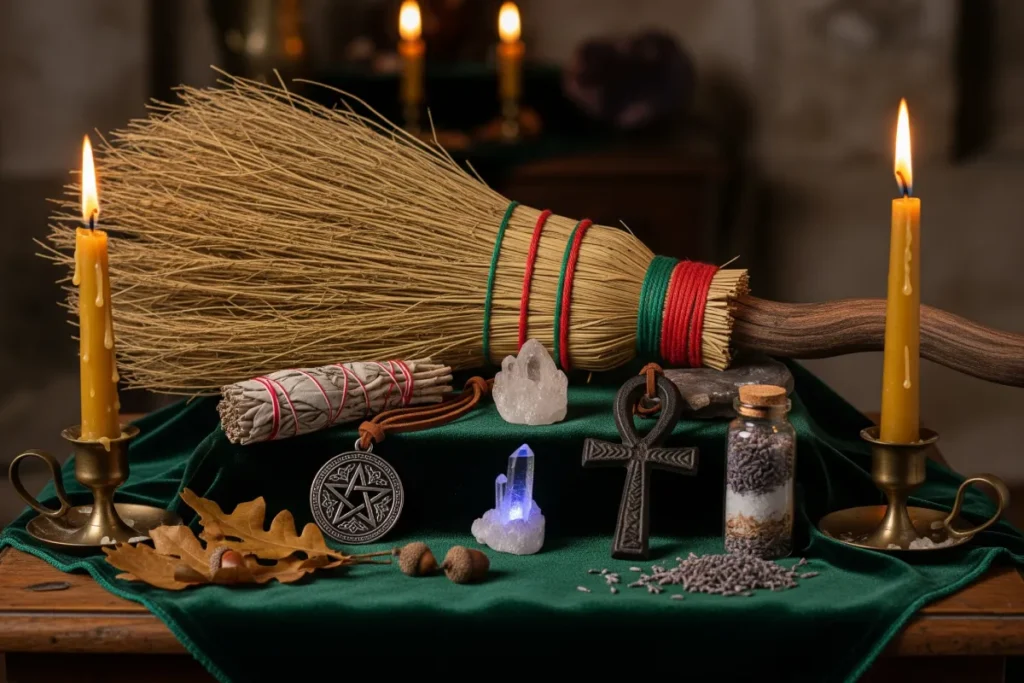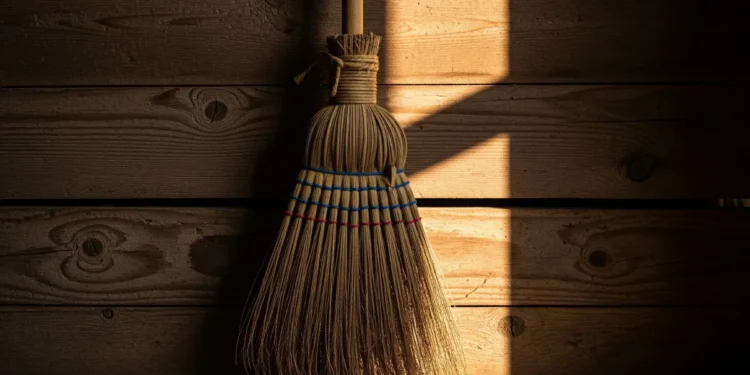A social history of history of the broom that traces its role from a practical cleaning tool to a symbol—used in rituals, domestic labor, politics, folklore, and campaigns of public order.
Table of Contents
Introduction
The history of the broom begins not with an invention, but with an impulse: the primal need to draw a line between the chaos of the outside world and the sanctuary of the inside. Leaning in a closet or tucked behind a door, the modern broom is a monument to our collective amnesia —a tool so familiar that it has become invisible. Yet, its simple form is a deception. To dismiss it as a mere cleaning implement is to ignore a rich and deeply conflicted past. This object, seemingly defined by its function, is in fact a dense cultural artifact, encoded with centuries of belief, power dynamics, and social anxiety.
This article peels back those layers of assumption. We will begin by tracing the broom’s earliest forms, exploring how a bundle of twigs became intrinsically linked to the concept of the hearth and the very definition of “home.” From there, we will pivot into the realm of folklore, investigating how this humble domestic tool was dramatically hijacked by whispers of witchcraft, becoming a potent symbol of female subversion and occult power. We will also uncover its gentler, ritualistic uses, from spiritual cleansings to the profound tradition of jumping the broom, exposing a far more nuanced history of broom folklore than is commonly understood.
The journey continues into the industrial age, where the Shaker flat broom revolutionized not just cleanliness but the very nature of domestic labor, raising standards while deepening the invisibility of women’s work. We will analyze the consequences of the history of the broom as it was weaponized for social control—a tool for “cleaning up” cities and enforcing public order. Finally, we will arrive in the present, questioning the broom’s place in an age of robotic vacuums and exploring its surprising resurgence as an artisanal object. This is not just a timeline; it is an argument that the simple broom has been a silent, powerful agent in shaping our world.
The Primitive Sweep: Forging the Earliest History of the Broom
To begin understanding the history of the broom is to discard the notion of a single inventor and instead confront a story of pure human instinct. Long before patents and factories, the first brooms were crude, anonymous bundles of twigs, grasses, or reeds lashed to a stick. This initial phase of the history of the broom wasn’t about aesthetics or efficiency but about a fundamental act of survival: separating the ordered domestic sphere from the chaos of the natural world. Clearing a dirt floor was not just tidying; it was a primal act of establishing territory and safety, making this early history of the broom a narrative of human civilization itself.
The form of these early implements was dictated entirely by geography, grounding the material history of the broom in the soil of its creation. In Europe, tough twigs from birch or besom corn were common, creating coarse, durable tools for rugged floors. In other regions, bundled palm fronds, long grasses, or pliable reeds served the same purpose. This reality means there is no single, linear history of the broom, but rather a constellation of parallel histories, each shaped by local botany. The tool was an extension of its environment, a tangible link between the domestic space and the wildness just beyond its threshold.
More than any other space, the broom’s primal connection was to the hearth. As the center of warmth, food, and safety, the hearth had to be kept clean of flammable debris and ash. This functional necessity imbued the broom with a profound symbolic weight from its very conception. The act of sweeping around the fire cemented the tool as a guardian of the domestic core. This deep history of the broom reveals it was never just for cleaning floors; it was for maintaining the sacred boundary of home, making it one of the first and most essential tools in the long, complex social history of the broom.

Witches and Whispers: How Folklore Hijacked the History of the Broom
As the broom became a fixture of domestic life, a parallel narrative began to take shape—one that pulled the tool from the hearth and thrust it into the realm of magic and subversion. This symbolic turn represents a crucial hijacking of the history of the broom. In European folklore, the broom became inextricably linked with witchcraft, transforming from a symbol of a woman’s domain into a vessel for her supposed occult power.
The image of a witch riding a broomstick is not just a fantasy; it’s a powerful cultural artifact that subverts domesticity, recasting the keeper of the home as a figure of chaos. This chapter of the history of the broom is deeply gendered, revealing anxieties about female agency.
Long before it was associated with malevolent witchcraft, however, the broom played a significant role in folk rituals. Rethinking the history of the broom requires looking at its pre-Christian roots in pagan and earth-based traditions. Brooms were used to symbolically “sweep away” evil spirits, bad luck, or the remnants of the old year during solstice celebrations. They were tools of spiritual cleansing, not just physical. This broom folklore history positions the tool as an instrument of purification and renewal, connecting it to fertility rites and protective charms placed over doorways—a far cry from the sinister narrative that would later dominate the popular imagination.
This richer broom and ritual connection is beautifully preserved in the tradition of “jumping the broom.” Originating in various cultures, including Welsh Romani and Celtic communities, the practice was adopted by enslaved African Americans in the United States as a public declaration of marriage when their unions were not legally recognized. The act of sweeping the ground before the jump and then leaping over the broom together symbolizes a new beginning and a sweeping away of the past. This powerful ritual provides a poignant counter-narrative, reclaiming the broom as a symbol of commitment, resilience, and the creation of community in the face of oppression, adding a deeply moving layer to the history of the broom.
The Shaker Revolution: Industrializing the History of the Broom and Domestic Labor
For centuries, the fundamental design of the broom remained unchanged—a round bundle of bristles ill-suited for corners and flat surfaces. This long stagnation in the history of the broom was shattered in the early 19th century by the Shakers. With their ideological commitment to efficiency, order, and innovation, they engineered the flat broom. By stitching the broom corn flat and securing it with a wire vice, they created a tool that was dramatically more effective. This wasn’t merely a practical improvement; it was a physical manifestation of a worldview that valued precision and control, forever altering the trajectory of the modern history of the broom.
The consequences of this new efficiency were profound and deeply gendered. The “better” broom did not lead to less work for women; it led to higher standards of cleanliness. With a tool that could now reach every corner and crevice, the expectation of a spotless home became the new domestic norm. This development inadvertently increased the burden of domestic labor, making it more intensive while keeping it just as invisible. In this sense, one of the most celebrated innovations in the history of the broom also became an instrument that deepened the drudgery and relentless pressure associated with housework.
The success of the Shaker design also marked the broom’s transition from a handcrafted, personal object to a mass-produced commodity. Factories began churning out standardized brooms, making them cheap and widely available. This industrial turn is a key part of the commercial history of the broom, transforming it into just another household product to be purchased. While this democratized access to the tool, it also stripped it of its individuality and connection to the land, finalizing its role as a cog in the machinery of the modern, consumerist home.

The Politics of Cleanliness: Weaponizing the History of the Broom for Social Order
Beyond the walls of the home, the broom was co-opted as a powerful public symbol, an instrument for imposing social and political will. The simple act of sweeping was scaled up, transformed from a domestic chore into a metaphor for purification on a grand scale. This is where the flawed history of the broom becomes most apparent, as its association with order was weaponized to enforce conformity. The tool used to create a tidy household was repurposed to engineer a tidy society, often with coercive and discriminatory aims, revealing a darker dimension to the cultural meaning of sweeping.
This metaphorical power found its most potent expression in the public health movements of the 19th and 20th centuries. As cities swelled, anxieties about disease, poverty, and immigration grew, and the broom became a symbol of the campaign to “clean up” urban spaces. “Sweeping the slums” was not just a sanitation project; it was a class-based and often racially charged crusade to remove “undesirable elements.” The history of the broom in this context is inseparable from the history of social engineering, where the language of hygiene was used to justify the policing of marginalized communities.
The broom’s symbolism proved remarkably adaptable, finding its way into modern political rhetoric. The phrase “a clean sweep” in an election speaks to a desire for radical, purifying change, casting opponents as dirt to be removed. In a powerful inversion, activists have also claimed the broom as a tool of protest. By publicly sweeping streets after a demonstration or in neglected areas, they perform a quiet act of civic responsibility that shames government inaction. This dual legacy—as a tool for both state-enforced order and grassroots dissent—cements the complex and ongoing political history of the broom.
Rethinking the History of the Broom: From Drudgery to Digital Dustbusters
The 20th and 21st centuries introduced a dramatic plot twist in the history of the broom: its own obsolescence. The roar of the vacuum cleaner, and later the quiet hum of the robotic dustbuster, promised to liberate the modern home from the manual labor the broom represented. This technological displacement marks a profound shift in our domestic lives. The broom, for millennia the primary tool for cleaning, was relegated to the closet, becoming a specialist for small messes rather than the master of the floor. This recent history of the broom is a story of being sidelined by the very promise of efficiency it once championed.
This technological evolution reveals much about our changing relationship with domestic work. The advent of automated cleaners completes the process of making labor invisible, distancing us from the physical act of tidying our own spaces. The sweeping motion—a direct, tangible connection between a person and their environment—has been replaced by the passive act of pushing a button. In doing so, we have outsourced a fundamental part of homemaking to machines. This chapter in the history of the broom reflects a cultural desire to achieve order without effort, and cleanliness without contact.
And yet, the broom endures. In a fascinating cultural rebound, it is experiencing a resurgence not as a tool of necessity, but as one of choice. Artisanal, handcrafted brooms are now sought after as objects of sustainable design and minimalist beauty. This modern appreciation is not despite the tool’s simplicity, but because of it. In an age of disposable technology, the broom’s long, complicated past imbues it with an authenticity that a robot cannot replicate. This latest chapter in the ongoing history of the broom sees it transformed from a symbol of drudgery into a conscious statement of value.

Conclusion
From its genesis as a bundle of twigs defining the sacred space of the hearth, the broom has always been more than the sum of its parts. We have traced its journey as it was simultaneously revered and feared, becoming a central figure in folklore—a tool for spiritual cleansing in one tradition, and a vessel for subversive witchcraft in another. This initial duality reveals a core tension that has defined the history of the broom: its capacity to represent both comforting order and threatening chaos, often depending on whose hands held it.
The dawn of the industrial era did not simplify this legacy but complicated it further. The Shaker flat broom, a marvel of practical design, became an instrument that intensified the demands of domestic labor, quietly reinforcing gendered norms under the guise of efficiency. This power to shape private lives was soon mirrored in the public sphere, where the broom was weaponized as a metaphor for social purification and political control. Its history in the modern age is a stark reminder that the most mundane domestic tools can be co-opted as instruments of power, used to enforce who belongs and who must be “swept away.”
Ultimately, the complete history of the broom reveals that its true function was never just to clean floors, but to negotiate the boundaries of our world—between home and wilderness, order and disorder, purity and pollution, power and submission. Its story, from the hearth to the hex, from the factory to the protest line, is a mirror reflecting our own evolving beliefs about labor, gender, and community. The next time you see this simple object, consider what it has built, what it has enforced, and what it has swept under the rug. Its silent history is woven into the very fabric of our domestic and political lives.







